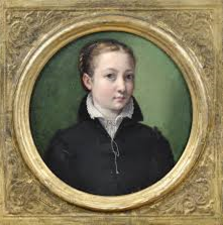Historical Research: Novels, Lecture Notes, and Art History

This essay was taken from a handout provided at my lecture given at the Society for Creative Anachronism's (SCA) Pennsic War.
Clothing for the Middle and Lower Classes in the
Late 16th and Early 17th Century: Historical Overview
The study of middle and lower class garments is something that must be approached a little differently from our usual study of court garb. Because the middle and lower classes did not change their clothing style as quickly as did the nobility, it is often difficult to tell the dating of a style based on its silhouette.


This Bibliography was taken from a handout provided at my lecture about Eleonora of Toledo (Eleonora de Toledo) at the Society for Creative Anachronism's (SCA) Pennsic War,
Duke Cosimo de I Medici of Florence and Duchess Eleonora of Toledo of Florence:
A Selected Bibliography
Anquetil, Jacques: Silk. New York: Flammarion. 1996
Arnold, Janet: Patterns of Fashion: The Cut and Construction of Clothes for Men and Women 1560-1620. New York: Drama Books. 1985.
________ Preliminary Investigation into the Medici Grave Clothes. Il Costume nell' etas' del Rinascimento. (No publisher available) Florence: 1988.
________ A personal letter to Monica E. Spence, 1992.

This essay is based on my research on Italian Renaissance painter Sofonisba Anguissola, who is the protagonist in my novel (in progress), An Illustrious Woman.
NUANCES OF SHADE: Sofonisba Anguissola and her Art
Placing her in Context
By: Monica E. Spence
There are men and women who put their stamp on a particular subject because of their work: Sofonisba Anguissola is one such woman. Sofie watched Michelangelo’s muscular Mannerist style of the late Renaissance transform into the intricate, decorative style of Van Dyck’s Baroque period[1]. Each style blended into the other, and yet was visually, subjectively and contextually different from the styles established since the Thirteenth Century by Cimabue and Giotto.

Unsung Hero and Spy 1813
(Wikimedia Commons: Raynham Hall Museum)
This essay is based upon my Author's notes from my historical Romance novel, C1PHER, which is available as an ebook from Amazon, Barnes and Noble and from the publisher, The Wild Rose Press.
C1PHER is a work of historical fiction, with the tale carefully straddling history and storytelling, but there are times that truth is stranger than fiction. Writing Historical Fiction is like making a fresh loaf of bread. Kneading facts into the story mix must be leavened with a healthy dose of imagination. If there is too much fact or fiction, it becomes something else: fantasy, alternate history, biography, creative non-fiction, etc.